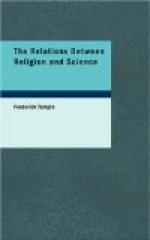Having established this interpretation of these words, Hume goes on to ask: What can be the ground in reason for the principle universally adopted, that the law of cause and effect rules phenomena, and that a cause which has been followed by an effect once will be followed by the same effect always? And he concludes that no rational ground can be found at all, that it is the mere result of custom without anything rational behind it. We are accustomed to see it so, and what we have been so perpetually accustomed to see we believe that we shall continue to see. But why what has always been hitherto should always be hereafter, no reason whatever can be given. The logical conclusion obviously is to discredit all human faculties and to land us in universal scepticism.
It was at this point that Kant took up the question, avowedly in consequence of Hume’s reasoning. He considered that Hume had been misled by turning his attention to Physics, and that his own good sense would have saved him from his conclusion had he thought rather of Mathematics. Kant’s solution of the problem, based mainly on the reality of Mathematics, and especially of Geometry, is the direct opposite of Hume’s.
It will be most easy to give a clear account of Kant’s solution by using a very familiar illustration. There is a well-known common toy called a Kaleidoscope, in which bits of coloured glass placed at one end are seen through a small round hole at the other. The bits of glass are not arranged in any order whatever, and by shaking the instrument may be rearranged again and again indefinitely and still without any order whatever. But however they may be arranged in themselves they always form, as seen from the other end, a symmetrical pattern. The pattern indeed varies with every shake of the instrument and consequent re-arrangement of the bits of glass, but it is invariably symmetrical. Now the symmetry in this case is not in the bits of glass; the colours are there no doubt, but the symmetrical arrangement of them is not. The symmetry is entirely due to the instrument. And if a competent enquirer looks into the instrument and examines its construction, he will be able to lay down with absolute certainty the laws of that symmetry which every pattern as seen through the instrument must obey.
Just such an instrument, according to Kant, is the human mind. Space and Time and the Perceptive Faculties are the parts of the instrument. Everything that reaches the senses must submit to the laws of Space and Time, that is, to the Laws of Mathematics, because Space and Time are forms of the mind itself, and, like the kaleidoscope, arrange all things on their way to the senses according to a pattern of their own. This pattern is as it were super-added to the manifestations that come from the things themselves; and if there be any manifestations of such a nature that they could not submit to this addition, or, in other words, could not submit to Mathematical Laws,




